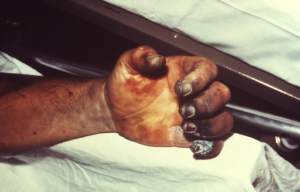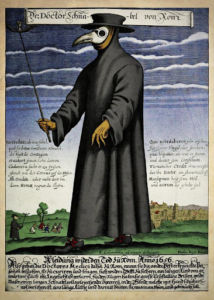Everything You Ever Wanted To Know About the Black Plague
The current pandemic has made many people curious about epidemiology and the history of epidemic diseases. Everyone who knows I have a history degree has asked me about the Black Plague. Here at Castle of Chaos we know you like to be morbidly entertained, so here you go, everything you ever wanted to know about the Black Plague and then some:

An Oriental rat flea infected with yersinia pestis (the black mass in its abdomen.)
1.What Exactly is the Black Plague?
The disease known as the Black Plague is caused by the bacteria yersinia pestis. The bacteria is believed to have emerged in Asia over 2000 years ago. It infects fleas, primarily the Oriental or Indian Rat Flea. The bacteria forms a mass in the flea’s digestive system, blocking it off. The fleas continue to feed, and when they do, they regurgitate the bacteria into their victim. Most of their victims are rats, but they can infect anything or anyone that they bite. The plague spreads through flea bites and contact with the body fluids of infected animals or people.
Bubonic Plague is another name for the Black Plague; it refers to the Bubo’s or swollen lymph nodes that form on victims. Sometimes the plague travels to the lungs and becomes Pneumonic Plague. In these cases, it becomes airborne, but the airborne transmission does not seem to be as contagious as direct transmission through flea bites or body fluids.
So what does it feel like to have the plague? Pretty awful. First, you will notice hugely swollen lymph nodes at the neck, groin or underarm that weep pus and fluid. You will also have very high fevers, nausea, extreme weakness, blackening of skin on your extremities, and bleeding from your nose, mouth, rectum, or under your skin. Thankfully you won’t have to suffer long because if it’s not treated with antibiotics, it will kill you within 3 to 5 days (or you’ll start feeling better after about a week). Before antibiotic treatment was available, the plague killed 30% to 50% of those infected. With antibiotic treatment, about 10% of victims die.
There are “Plague Reservoirs” all around the world. These are places where the plague circulates among rodents at a low rate; most of the rodents in the area do not die off, so humans are more at risk for coming into contact with them or their infected fleas.

Necrosis of the hand caused by plague. This was especially common during the Plague of Justinian.
2.How Many Plague Epidemics Have There Been?
Most people know about the Black Death, the epidemic of Bubonic Plague that demolished Europe in the 1300s, but there have actually been three major recorded outbreaks. Beginning in the year 541, the plague swept through central Asia and the Mediterranean, eventually making its way as far north as England. This outbreak is known as the Plague of Justinian, named after the ruler of the Byzantine Empire. At the time, Justinian ruled most of Southern Europe and the Eastern Mediterranean.
Modern genetic studies have shown that the strain that caused the Plague of Justinian came from a plague reservoir in central Asia or china. The plague spread around the known world during the Justinian outbreak through two activities that were constant in the Byzantine Empire: War and trade. Rats, especially black rats like to live on ships and in other places near people. “Plague ships” spread the disease far and wide in a stunningly short amount of time. This outbreak raged for three years and killed between one-fourth and one-half of the known world’s population. There were other more isolated outbreaks in the affected areas for another hundred years.
The Black Death that hit Europe 800 years later was caused by a different strain of the same bacteria that was once again spread through trade and war. Fleas can infest cloth, grain, and other trade goods and pass to humans who touch these things. Thus the disease can be transmitted to people who haven’t been in direct contact with rodents or other infected animals.
When the Black Death hit Europe in 1347, the continent was overpopulated, and many people were undernourished. These factors may have contributed to the spread and mortality of the disease. By the time the worst of the outbreak ended in 1352, a quarter of Europe’s population was dead. A second outbreak in 1361 killed an additional 10-20% of the remaining population. During the initial outbreak, the plague was spread from Europe to Asia and Africa, where another 25 million people died. Society, especially in Europe, changed drastically after this. There were some positive outcomes. The demand for labor drove up wages for the working classes and gave serfs more freedom to choose what lord they worked for.
During the time of Shakespear in 1665-66 The Great Plague of London, an outbreak of Pneumonic Plague, killed a fifth of the city’s population. In 1666 the Great Fire of London burned many wood and thatch buildings. These were replaced with brick and tile buildings that were not as attractive to rats. This is thought to have contributed to the end of the outbreak.
The most recent pandemic outbreak of the Bubonic Plague occurred in 1894. This time the plague spread from China around the world over several years. It killed 60,000 people in China within a few weeks. The outbreak waxed and waned for the whole first half of the twentieth century, popping up in one place, dying down and then coming back somewhere else. By 1959 around 15 million people worldwide had died from it.

The Triumph of Death by Pieter Breugel the Elder
3.How Did People Deal?
That’s a good question. Now when we hear a pandemic is headed our way, we rush out and buy toilet paper. Back in the day, people employed a variety of odd and mostly not useful techniques for dealing with the black plague. Old-Timey Doctors used to bleed patients in an attempt to restore the proper balance of “humours” or body fluids.
Since bacteria weren’t discovered until the 19th century, people were on their own to come up with what they thought was causing the terrible sickness. Some thought it was caused by the wrath of God or by astrological events or natural disasters. It was common for flagellants to walk through towns, whipping themselves as a sign of repentance and praying for God’s mercy.
During the European Black Death, people also thought that the plague was caused by “miasma”, the foul odors that seep from dead bodies or from an infected person’s breath. Doctors wore plague masks to keep them from breathing miasma while treating patients.
(Insert Picture Here)
The beaks on the masks were filled with dried herbs or flowers to keep the bad smells away. I think it’s fair to say that medieval protective gear looked a lot cooler than the stuff we have now.
The one medieval idea that proved useful was quarantine. The word comes from the Italian for 40 days. Italian port authorities during the Black Death began forcing sailors on incoming ships to stay aboard for 40 days before disembarking. The idea caught on, and quarantine measures were eventually enforced in many areas. It was probably too little too late during the Black Death, but earlier quarantine measures during subsequent outbreaks have helped to slow the spread of the disease.

The beaks on the plague masks were stuffed with herbs and flowers to keep the bad smells away. I think it’s fair to say that medieval protective gear looked a lot cooler than the stuff we have now.
4.Is the Plague Still a Problem Today?
Yes and no. In many areas of Africa, South America, and Asia, plague outbreaks still occur regularly. Urban outbreaks of plague have occured, (most notably in L.A. in 1924.), but plague is most common in rural areas. Societies where most people live in cities often have a lower incidence of plague because people are not in close contact with rodents and the places they like to nest. Modern sewage systems and water treatment have also made it more difficult for plague to spread.
An average of seven people contract the plague every year in the U.S. Most cases originate in the plague reservoir in the Southwest. Health officials test rodents for the plague and use flea killing insecticide in areas where animals have tested positive. As long as these precautions are taken, it is unlikely that the plague will reach epidemic levels in the western world through any natural means.
So there you have it. Now you know some really fun phrases like “plague reservoir” and can go impress your friends or name your band.






